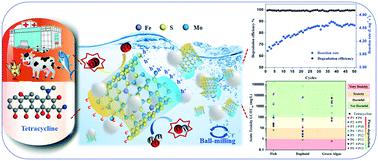当前位置:
X-MOL 学术
›
Environ. Sci.: Nano
›
论文详情
Our official English website, www.x-mol.net, welcomes your
feedback! (Note: you will need to create a separate account there.)
A tribo-positive Fe@MoS2 piezocatalyst for the durable degradation of tetracycline: degradation mechanism and toxicity assessment
Environmental Science: Nano ( IF 5.8 ) Pub Date : 2020-04-30 , DOI: 10.1039/d0en00284d Fanqing Meng 1, 2, 3, 4 , Wei Ma 4, 5, 6, 7 , Yinglong Wang 1, 2, 3, 4 , Zhaoyou Zhu 1, 2, 3, 4 , Zhen Chen 4, 5, 6, 7 , Guang Lu 4, 8, 9, 10
Environmental Science: Nano ( IF 5.8 ) Pub Date : 2020-04-30 , DOI: 10.1039/d0en00284d Fanqing Meng 1, 2, 3, 4 , Wei Ma 4, 5, 6, 7 , Yinglong Wang 1, 2, 3, 4 , Zhaoyou Zhu 1, 2, 3, 4 , Zhen Chen 4, 5, 6, 7 , Guang Lu 4, 8, 9, 10
Affiliation

|
The elimination of antibiotics by piezo-catalysis has recently attracted considerable attention due to its advantages in engineering applications. However, the risk assessment of target antibiotics and their degradation intermediates during the piezo-degradation process are rarely researched. Herein, a tribo-positive Fe@MoS2 piezo-catalyst with a significantly extended lifetime was synthesized via a simple mechanochemical process. The as-prepared Fe@MoS2 showed superior piezo-catalytic activity via ball-milling activation. The characterization and density functional theory calculation results demonstrated that the high piezoelectric property of Fe@MoS2 is ascribed to its few-layered microstructure and semi-metallic nature. The destruction of its piezo-catalytic sites was successfully eliminated by using the wet ball-milling method as the driving force. After 50 cyclic tests, the piezo-degradation efficiency of Fe@MoS2 for tetracycline still remained above 99%. The radical quenching results and electron paramagnetic resonance spectra indicated that both ˙OH and 1O2 were generated and took part in the degradation of tetracycline. A possible degradation pathway was proposed based on three-dimensional excitation–emission matrix fluorescence spectroscopy and LC-MS. More importantly, the toxicity changes during the degradation of tetracycline were evaluated using a bioluminescence inhibition test and the Ecological Structure Activity Relationship (ECOSAR) program. The toxicity of most of the intermediates was obviously lower than that of tetracycline, which suggests the potential of Fe@MoS2 in reducing the toxicity of effluents. This work provides a deeper understanding of the role of loaded Fe in piezo-catalysis and gives a new perspective for practical piezo-catalytic degradation to effectively reduce the amount and toxicity of antibiotics in water.
中文翻译:

三环素持久降解的摩擦阳性Fe @ MoS2压电催化剂:降解机理和毒性评估
由于其在工程应用中的优势,通过压电催化消除抗生素最近引起了相当大的关注。然而,很少有人研究在压电降解过程中目标抗生素及其降解中间体的风险评估。在此,通过简单的机械化学过程合成了具有显着延长的寿命的摩擦阳性的Fe @ MoS 2压电催化剂。所制备的Fe @ MoS 2通过球磨活化显示出优异的压电催化活性。表征和密度泛函理论计算结果表明,Fe @ MoS 2的高压电性能归因于其很少层的微观结构和半金属性质。通过使用湿式球磨法作为驱动力,成功消除了其压电催化部位的破坏。经过50次循环测试,Fe @ MoS 2对四环素的压电降解效率仍保持在99%以上。自由基猝灭结果和电子顺磁共振谱表明indicatedOH和1 O 2均产生并参与了四环素的降解。基于三维激发-发射矩阵荧光光谱和LC-MS,提出了可能的降解途径。更重要的是,使用生物发光抑制试验和生态结构活性关系(ECOSAR)程序评估了四环素降解过程中的毒性变化。大多数中间体的毒性明显低于四环素,这表明Fe @ MoS 2可以降低废水的毒性。这项工作使人们对负载的铁在压电催化中的作用有了更深入的了解,并为实际的压电催化降解提供了新的视角,以有效减少水中抗生素的数量和毒性。
更新日期:2020-06-18
中文翻译:

三环素持久降解的摩擦阳性Fe @ MoS2压电催化剂:降解机理和毒性评估
由于其在工程应用中的优势,通过压电催化消除抗生素最近引起了相当大的关注。然而,很少有人研究在压电降解过程中目标抗生素及其降解中间体的风险评估。在此,通过简单的机械化学过程合成了具有显着延长的寿命的摩擦阳性的Fe @ MoS 2压电催化剂。所制备的Fe @ MoS 2通过球磨活化显示出优异的压电催化活性。表征和密度泛函理论计算结果表明,Fe @ MoS 2的高压电性能归因于其很少层的微观结构和半金属性质。通过使用湿式球磨法作为驱动力,成功消除了其压电催化部位的破坏。经过50次循环测试,Fe @ MoS 2对四环素的压电降解效率仍保持在99%以上。自由基猝灭结果和电子顺磁共振谱表明indicatedOH和1 O 2均产生并参与了四环素的降解。基于三维激发-发射矩阵荧光光谱和LC-MS,提出了可能的降解途径。更重要的是,使用生物发光抑制试验和生态结构活性关系(ECOSAR)程序评估了四环素降解过程中的毒性变化。大多数中间体的毒性明显低于四环素,这表明Fe @ MoS 2可以降低废水的毒性。这项工作使人们对负载的铁在压电催化中的作用有了更深入的了解,并为实际的压电催化降解提供了新的视角,以有效减少水中抗生素的数量和毒性。









































 京公网安备 11010802027423号
京公网安备 11010802027423号